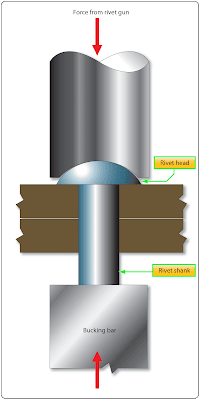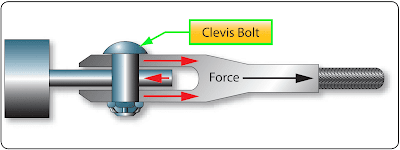Whenever a machine is in operation, be it a simple machine like a lever or a screw, or a more complex machine like an aircraft piston engine or a hydraulically operated landing gear, the parts and pieces of that machine will experience something called stress. Whenever an external force is applied to an object, like a weight pushing on the end of a lever, a reaction will occur inside the object which is known as stress. Stress is typically measured in pounds per square foot or pounds per square inch (psi).
External force acting on an object causes the stress to manifest itself in one of five forms, or combination of those five. The five forms are tension, compression, torsion, bending, and shear.
On turbine engine test cells, the thrust of the engine is typically measured by what are called strain gages. When the force, or thrust, of the engine is pulling out against the strain gages, the amount of distortion is measured and then translated into the appropriate thrust reading.
External force acting on an object causes the stress to manifest itself in one of five forms, or combination of those five. The five forms are tension, compression, torsion, bending, and shear.
Tension
Tension is a force that tries to pull an object apart. In the block and tackle system discussed earlier in Simple Machines article the upper block that housed the two fixed pulleys was secured to an overhead beam. The movable lower block and its two pulleys were hanging by ropes, and the weight was hanging below the entire assembly. The weight being lifted would cause the ropes and the blocks to be under tension. The weight is literally trying to pull the rope apart, and ultimately would cause the rope to break if the weight was too great.Compression
Compression is a force that tries to crush an object. An excellent example of compression is when a sheet metal airplane is assembled using the fastener known as a rivet. The rivet passes through a hole drilled in the pieces of aluminum, and then a rivet gun on one side and a bucking bar on the other apply a force.
This applied force tries to crush the rivet and makes it expand to fill the hole and securely hold the aluminum pieces together. [Figure 1]
This applied force tries to crush the rivet and makes it expand to fill the hole and securely hold the aluminum pieces together. [Figure 1]
Torsion
Torsion is the stress an object experiences when it is twisted, which is what happens when torque is applied to a shaft. Torsion is made up of two other stresses: tension and compression. When a shaft is twisted, tension is experienced at a diagonal to the shaft and compression acts 90 degrees to the tension. [Figure 2]The turbine shaft on a turbofan engine, which connects to the compressor in order to drive it, is under a torsion stress. The turbine blades extract energy from the high velocity air as a force in pounds. This force in pounds acts along the length from the blades to the center of the shaft, and creates the torque that causes rotation. [Figure 3]
Bending
An airplane in flight experiences a bending force on the wing as aerodynamic lift tries to raise the wing. This force of lift causes the skin on the top of the wing to compress and the skin on the bottom of the wing to be under tension. When the airplane is on the ground sitting on is landing gear, the force of gravity tries to bend the wing downward, subjecting the bottom of the wing to compression and the top of the wing tension. [Figure 4] During the testing that occurs prior to FAA certification, an airplane manufacturer intentionally bends the wing up and down to make sure it can take the stress without failing.Shear
When a shear stress is applied to an object, the force trues to cut or slice through, like a knife cutting through butter. A clevis bolt, which is often used to secure a cable to a part of the airframe, has shear stress acting on it. As shown in Figure 5, a fork fitting is secured to the end of the cable, and the fork attaches to an eye on the airframe with the clevis bolt. When the cable is put under tension, the fork tries to slide off the eye by cutting through the clevis bolt. This bolt would be designed to take very high shear loads.Strain
If the stress acting on an object is great enough, it can cause the object to change its shape or to become distorted. One characteristic of matter is that it tends to be elastic, meaning it can be forced out of shape when a force is applied and then return to its original shape when the force is removed. When an object becomes distorted by an applied force, the object is said to be strained.On turbine engine test cells, the thrust of the engine is typically measured by what are called strain gages. When the force, or thrust, of the engine is pulling out against the strain gages, the amount of distortion is measured and then translated into the appropriate thrust reading.
A deflecting beam style of torque wrench uses the strain on the drive end of the wrench and the resulting distortion of the beam to indicate the amount of torque on a bolt or nut. [Figure 6]
RELATED POSTS
RELATED POSTS






